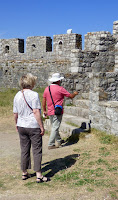We arrived in the capital Tirana just in time for an evening stroll and discovered a restaurant beside a lake with fascinating colourful fountains.
The following day we did a brief walking tour of the city. Luckily it was brief, for this is a city without charm that still seems shackled by its communist past.
We drove north to the city of Shkodra, with the fortified castle of Rozafa looming ahead.
It was occupied in the 3rd century BC, strategically placed at the confluence of three rivers and, as you can see by the previous photo, on very high ground. It was a huge complex that we enjoyed exploring though it was a very hot day.


One of my favourite places in Albania was Kruja. This was another fortified town.

In the castle grounds was what the Albanians refer to as an Ethnographic Museum (in our words, a National Trust home). This one was a restored 1764 house, a relative newby considering how old everything else was.

The restoration was very well done and each room captured the way of life superbly. This one was the womens's room where they would chat and entertain each other.
I was entranced by the exquisite embroidery on the clothes on display.


The Ottoman bazaar in the town was another fascinating place. It was restored in the 1960s but retains a unique atmosphere. The wooden shops have extra-long eaves that project over the cobbled street to protect the shops and goods from the weather. All goods were proudly claimed to be made in Albania - and I have to say, I never did see anything like the jewellery, laces and clothes anywhere else. I loved the mats but they were too heavy to bring back.


Durres, midway along the west coast, was the original capital of Albania. It started as a Greek colony in the 7th century BC. Here we explored a Roman amphitheatre. It's been partly restored. We were able to see where the audience entered, the gladiators' rooms, the cells for the animals.

The tiles from the seating are no longer there. The arena itself has not been restored and still holds the rubble and soil from the excavations. Here, an enthusiastic spectator cheers on a gladiator.

... but is not impressed with the next performance.

There was a real sense of the era here even though the site was abandoned as a gladiatorial arena, then repurposed, when the Romans converted to Christianity.
Next stop was Apollonia, another glimpse into the past. The history here is multi-layered with some areas pre-dating others by centuries. It was first settled by the Greeks; when the Romans came they used it as a centre of learning. It covers a huge area and archaeologists are always digging trenches to further their knowledge. They reckon only 10% has been uncovered.
 |
| The ruins of the library and Council rooms. |
 |
| Remains of the ancient marketplace. |
 |
| Steve trudges up yet another hill. We certainly kept up our fitness on these sites! |
Ali Pasha was a particularly vile ruler who killed anyone who he thought might pose a threat to him; he once had a man roasted alive on a spit!!!!! Byron visited here in 1809, staying at the castle at Ali Pasha's invitation, although in a letter to his mother Byron called him a 'remorseless tyrant, guilty of the most horrible cruelties'. We explored the various rooms; it was deliciously cold here.

Up on the roof area, a groom was taking photos of his bride.
After a while she seemed to get sick of the whole affair and I don't blame her as it was exceptionally hot. I did love her dress.
The water in the bay was gorgeous.

Another day we visited Butrint, a World Heritage site where the visible remains span two and a half millennia. Each conqueror added to the site so we saw evidence of Greek, Roman, Venetian and Byzantine structures. It was easy to walk around among shady trees. We saw the original 5th century BC walls, a Roman bath house and mosaics, aquaduct columns, fountains and wells, a baptistry and an amphitheatre.
 |
| Another amphitheatre. We saw quite a few on our trip but they still vividly conjured up the past for me as I could imagine the crowds enjoying a show. |
 |
| The Roman bathhouse |

It was a pleasant break from the past when we visited the Blue Eye natural water springs park, one of the most visited spots in Albania. The Blue Eye spring is at least 80 metres deep. It was a lovely, peaceful spot.

 |
| Here the spring bubbles up from the depths. Its name Blue Eye comes from its appearance. |
Gyrokastra (meaning Silver Castle) was a favourite of ours. Here we explored the castle, the town and another ethnographic museum.
 |
| A woman sits outside the castle making the lace for which the town is famous. |

 |
| On the right is an American spy plane captured by the communists in 1957. |
 |
| The museum recreated its era well. |

The town itself is built into a hill and the cobbled streets were extremely steep.


 |
| Our breakfast was delicious. |
 |
| The roads were very winding and we were constantly driving through mountain ranges. |

 |
| Steve took this photo. He loved taking photos of people whereas I tended to go for buildings and details. |
 |
| Men playing dominoes in the park - very seriously. |
 |
| We chose our trout from a plate of freshly caught fish. Yummy. |





















No comments:
Post a Comment